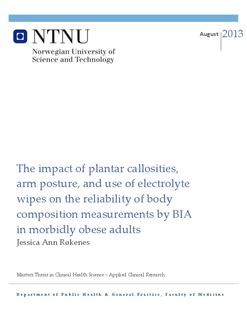| dc.description.abstract | Objective: The purpose of this study was to evaluate the reliability and validity of body
composition measurements in morbidly obese adults. These measurements were obtained
using multiple-frequency bioelectrical impedance analysis (BIA) under different
conditions: pre and post pedicure for removal of callosities, with and without InBody
electrolyte wipes and custom-built axillary pads. For validity purposes, body composition
measurements from BIA were compared with measurements from air displacement
plethysmography (ADP).
Design: Repeated measures, clinical intervention study testing the reliability and validity
of BIA in the morbidly obese.
Subjects: 36 morbidly obese patients from St. Olav University Hospital (13 males, 23
females, aged 28-70, BMI 41.6 ± SD 4.3) with moderate to severe callosities.
Measurements: Body composition was assessed as percentage of body fat (%BF) using
ADP and multiple-frequency BIA. Body weight and height measurements were also
taken; plantar callosities were photographed and scored for severity using a 5-point scale
by an authorized podiatrist. BIA measurements were taken before and after removal of
plantar callosities (pedicure), and with or without InBody electrolyte wipes and custombuilt axillary pads.
Results: The study participants’ %BF measurements were found to be significantly
higher with axillary pads than without (p < .001). No statistically significant differences
were found in %BF measurements pre to post pedicure, and with vs. without usage of
electrolyte wipes. There were also no statistically significant differences in %BF between
BIA and ADP.
Conclusion: Multiple-frequency BIA is a valid method for estimating %BF in morbidly
obese adults. Arm posture appears to have a significant impact on %BF assessed by BIA,
as opposed to the presence of plantar callosities and usage of InBody electrolyte wipes,
which showed no significant effect. Further examination of the effect of skin contact
between the arm and trunk on the accuracy of BIA measurements is warranted. For
clinical and scientific purposes, standardization of BIA measurement procedures is
recommended. | nb_NO |
